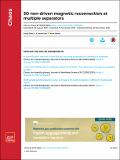3D non-driven magnetic reconnection at multiple separators
Date
20/12/2021Metadata
Show full item recordAbstract
Separators are important topological features of magnetic configuration for magnetic reconnection, commonly found in the solar plasma. They are located at the boundary shared among four distinctive flux domains; therefore, current layers easily build up around them. This paper aims to explore non-driven magnetic reconnection at multiple separators since little information is available about it. We have done two sets of experiments: non-resistive magnetohydrodynamic (MHD) relaxation and resistive MHD reconnection of a magnetic configuration consisting of two null points alongside their associated spines and three non-potential separators, which connect the same two null points. We used the LARE3D code for this purpose. The main current layers are formed along these separators where reconnection takes place. The reconnection occurs in two distinct phases: fast-strong and slow-weak. Most of the current dissipates at a fast rate, through Ohmic heating, during the fast-strong phase. The short-lived impulsive bursty reconnection events occur randomly in the slow-weak phase, while viscous heating exceeds Ohmic heating in this phase. The electric field component is parallel to field lines along the separators; likewise, the rate of reconnection along each of them evolved over time. However, work on separator reconnection has a strong potential to understand the underlying physics.
Citation
Zahid , Z , Parnell , C E & Qamar , A 2021 , ' 3D non-driven magnetic reconnection at multiple separators ' , Chaos , vol. 31 , no. 12 , 123123 . https://doi.org/10.1063/5.0065957
Publication
Chaos
Status
Peer reviewed
ISSN
1054-1500Type
Journal article
Description
Funding: We are thankful to the Higher Education Commission (HEC, Pakistan) for their financial support to one of the authors (Zarqa Zahid) under the IRSP program. We are also thankful to the School of Mathematics and Statistics, University of St. Andrews, North Haugh, St. Andrews, Scotland, UK, for accommodating one of the authors (Zarqa Zahid) in providing full support for the completion of this project.Collections
Items in the St Andrews Research Repository are protected by copyright, with all rights reserved, unless otherwise indicated.

